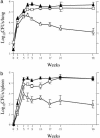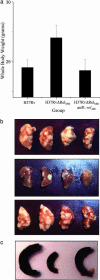The role of RelMtb-mediated adaptation to stationary phase in long-term persistence of Mycobacterium tuberculosis in mice
- PMID: 12897239
- PMCID: PMC187750
- DOI: 10.1073/pnas.1631248100
The role of RelMtb-mediated adaptation to stationary phase in long-term persistence of Mycobacterium tuberculosis in mice
Abstract
Long-term survival of nonreplicating Mycobacterium tuberculosis (Mtb) is ensured by the coordinated shutdown of active metabolism through a broad transcriptional program called the stringent response. In Mtb, this response is initiated by the enzymatic action of RelMtb and deletion of relMtb produces a strain (H37RvDeltarelMtb) severely compromised in the maintenance of long-term viability. Although aerosol inoculation of mice with H37RvDeltarelMtb results in normal initial bacterial growth and containment, the ability of this strain to sustain chronic infection is severely impaired. Significant histopathologic differences were noted in lungs and spleens of mice infected with H37RvDeltarelMtb compared with controls throughout the course of the infection. Microarray analysis revealed that H37RvDeltarelMtb suffers from a generalized alteration of the transcriptional apparatus, as well as specific changes in the expression of virulence factors, cell-wall biosynthetic enzymes, heat shock proteins, and secreted antigens that may alter immune recognition of the recombinant organism. Thus, RelMtb is critical for the successful establishment of persistent infection in mice by altering the expression of antigenic and enzymatic factors that may contribute to successful latent infection.
Figures




Similar articles
-
The Mycobacterium tuberculosis SigD sigma factor controls the expression of ribosome-associated gene products in stationary phase and is required for full virulence.Cell Microbiol. 2005 Feb;7(2):233-44. doi: 10.1111/j.1462-5822.2004.00454.x. Cell Microbiol. 2005. PMID: 15659067
-
Role of PPE18 protein in intracellular survival and pathogenicity of Mycobacterium tuberculosis in mice.PLoS One. 2012;7(12):e52601. doi: 10.1371/journal.pone.0052601. Epub 2012 Dec 28. PLoS One. 2012. PMID: 23300718 Free PMC article.
-
GLS/IL-12-modified Mycobacterium smegmatis as a novel anti-tuberculosis immunotherapeutic vaccine.Int J Tuberc Lung Dis. 2009 Nov;13(11):1360-6. Int J Tuberc Lung Dis. 2009. PMID: 19861007
-
Overexpression of Adenylyl Cyclase Encoded by the Mycobacterium tuberculosis Rv2212 Gene Confers Improved Fitness, Accelerated Recovery from Dormancy and Enhanced Virulence in Mice.Front Cell Infect Microbiol. 2017 Aug 17;7:370. doi: 10.3389/fcimb.2017.00370. eCollection 2017. Front Cell Infect Microbiol. 2017. PMID: 28861399 Free PMC article.
-
Mycobacterium tuberculosis H37Rv: Delta RD1 is more virulent than M. bovis bacille Calmette-Guérin in long-term murine infection.J Infect Dis. 2004 Jul 1;190(1):123-6. doi: 10.1086/421472. Epub 2004 Jun 11. J Infect Dis. 2004. PMID: 15195251 Free PMC article.
Cited by
-
The impact of drug resistance on Mycobacterium tuberculosis physiology: what can we learn from rifampicin?Emerg Microbes Infect. 2014 Mar;3(3):e17. doi: 10.1038/emi.2014.17. Epub 2014 Mar 12. Emerg Microbes Infect. 2014. PMID: 26038512 Free PMC article. Review.
-
Developmental transcriptome of resting cell formation in Mycobacterium smegmatis.BMC Genomics. 2016 Oct 26;17(1):837. doi: 10.1186/s12864-016-3190-4. BMC Genomics. 2016. PMID: 27784279 Free PMC article.
-
PE11 (Rv1169c) selectively alters fatty acid components of Mycobacterium smegmatis and host cell interleukin-6 level accompanied with cell death.Front Microbiol. 2015 Jun 23;6:613. doi: 10.3389/fmicb.2015.00613. eCollection 2015. Front Microbiol. 2015. PMID: 26157429 Free PMC article.
-
Polyphosphate deficiency in Mycobacterium tuberculosis is associated with enhanced drug susceptibility and impaired growth in guinea pigs.J Bacteriol. 2013 Jun;195(12):2839-51. doi: 10.1128/JB.00038-13. Epub 2013 Apr 12. J Bacteriol. 2013. PMID: 23585537 Free PMC article.
-
Homology Model of a Catalytically Competent Bifunctional Rel Protein.Front Mol Biosci. 2021 Feb 3;8:628596. doi: 10.3389/fmolb.2021.628596. eCollection 2021. Front Mol Biosci. 2021. PMID: 33763451 Free PMC article.
References
-
- Cegielski, J. P., Chin, D. P., Espinal, M. A., Frieden, T. R., Rodriquez Cruz, R., Talbot, E. A., Weil, D. E., Zaleskis, R. & Raviglione, M. C. (2002) Infect. Dis. Clin. North Am. 16, 1–58. - PubMed
-
- Betts, J. C., Lukey, P. T., Robb, L. C., McAdam, R. A. & Duncan, K. (2002) Mol. Microbiol. 43, 717–731. - PubMed
-
- Bishai, W. (2000) Nature 406, 683–685. - PubMed
Publication types
MeSH terms
Substances
Grants and funding
LinkOut - more resources
Full Text Sources
Other Literature Sources
Molecular Biology Databases

